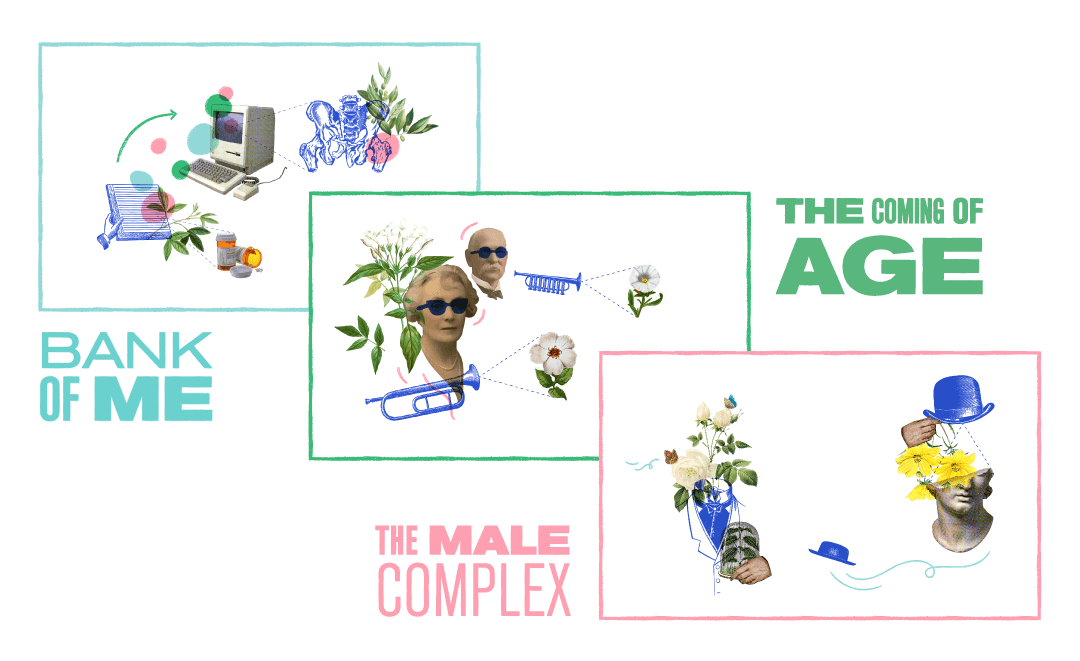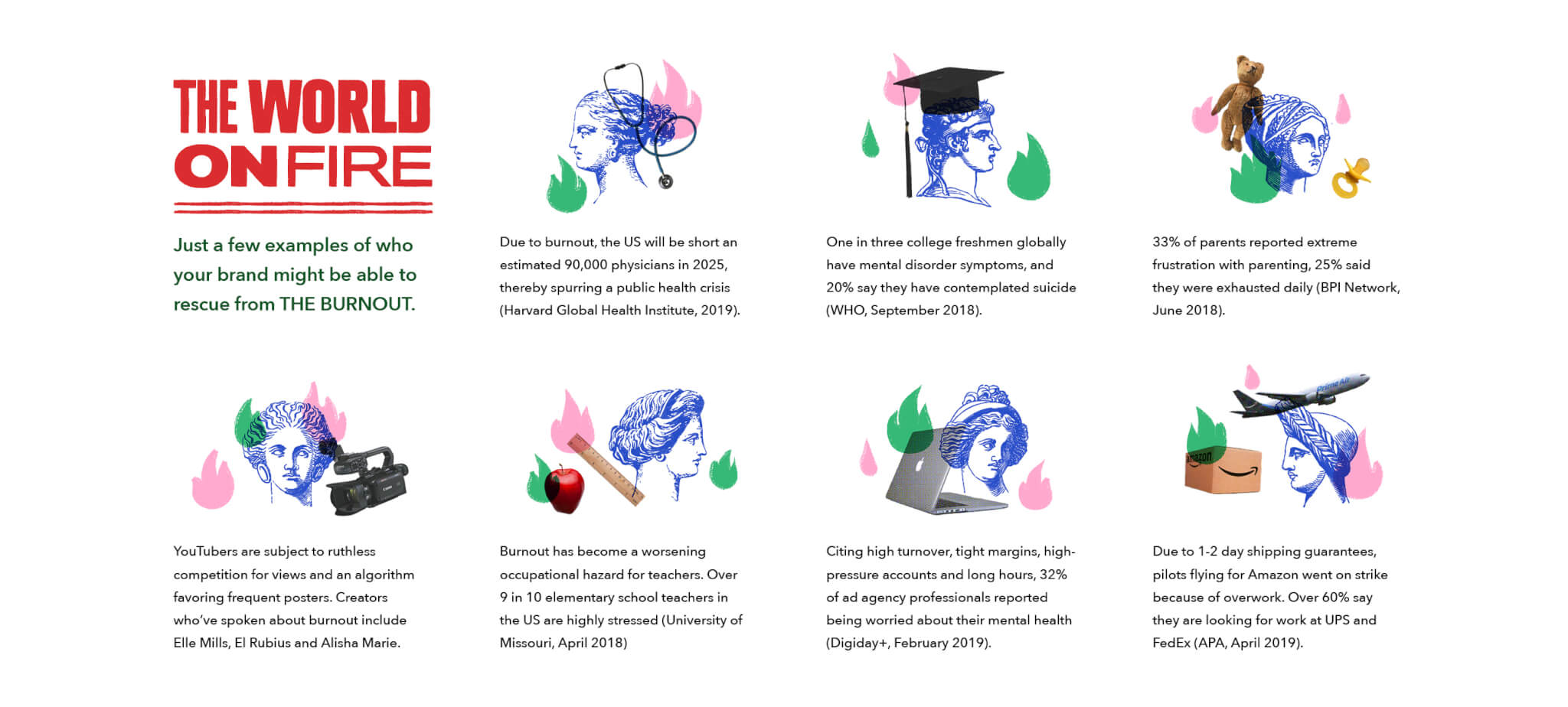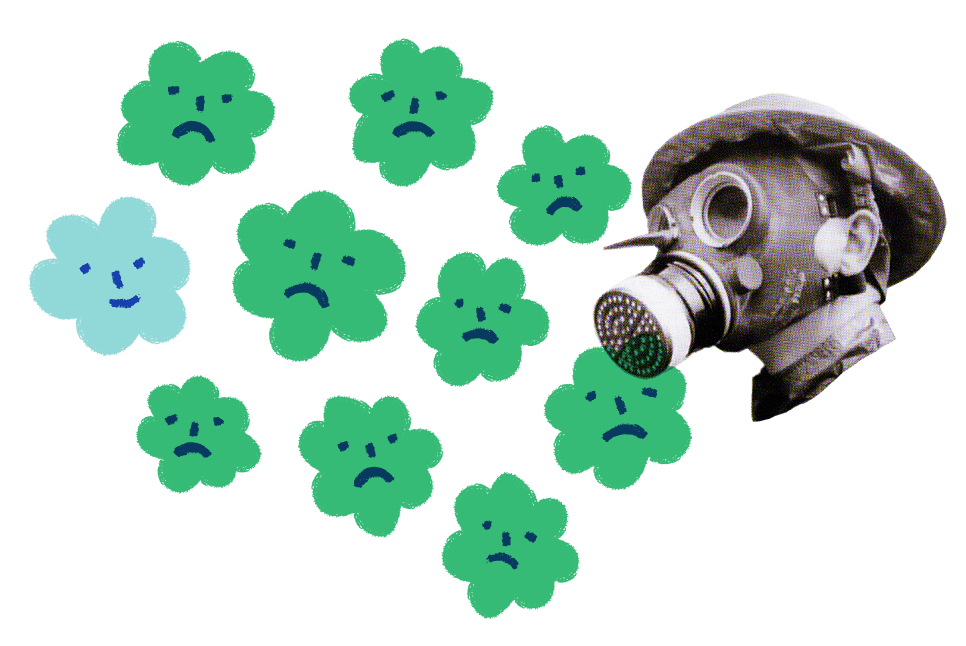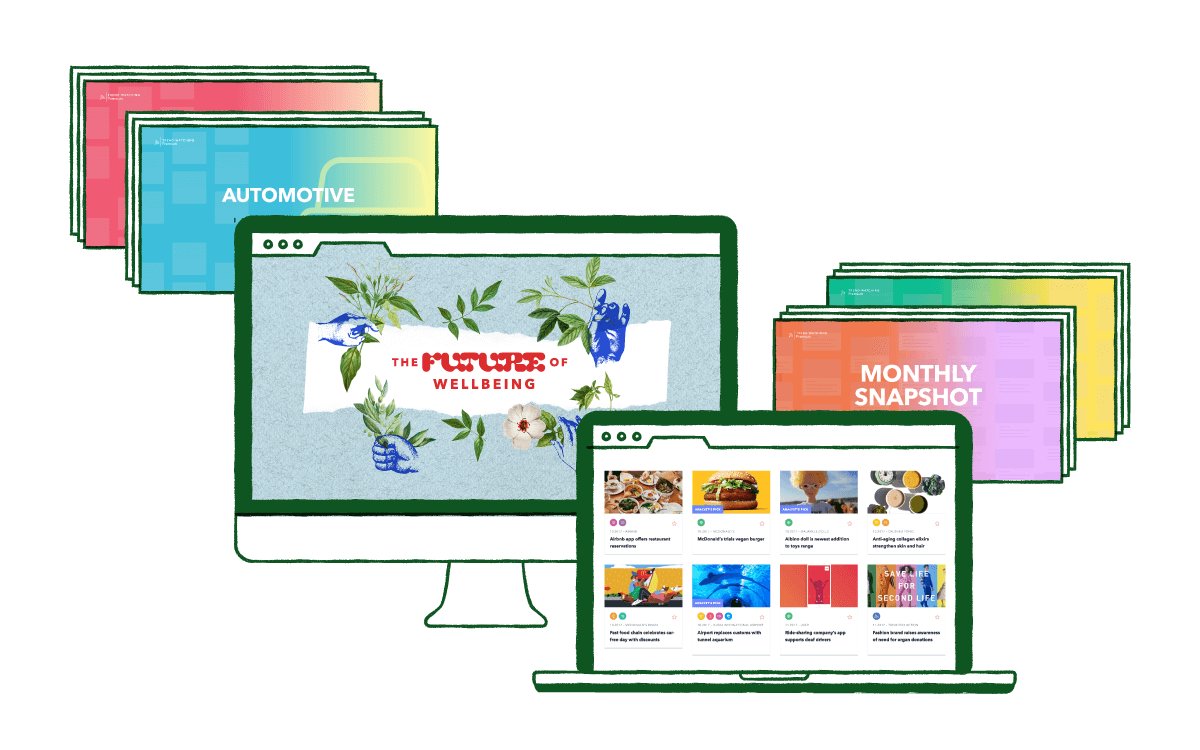The Future of Wellbeing
Two monumental challenges, laden with opportunity, impacting the health and happiness of consumers around the world.
The Future of Wellbeing
Two monumental challenges, laden with opportunity, impacting the health and happiness of consumers around the world.
In 2019, wellness penetrates every corner of the consumer landscape. Our friends at the Global Wellness Institute estimate the value of the global wellness economy to have hit $4.2 trillion in 2017, growing nearly twice as fast as overall economic growth from 2015 to 2017.
And yet instead of wellness, in this report, we’ve opted to focus on wellbeing.
This report isn’t dedicated to Insta-wellness: wellness as a status symbol, wellness for the wealthy, or spaces where one fad replaces the last. From gravity boots to Goop, wellness has come a long way. But it hasn’t truly solved our problems. On a treadmill of its own invention, the wellness market has humankind sweating, but without getting from A to B. So for now, put down that CBD mocktail, climb off the Peloton and wipe the charcoal-activated moisturizer off your face!
There are tougher-than-Tough-Mudder issues out there that threaten the wellbeing of billions of consumers. When it comes to thinking about The Future of Wellbeing, we’ve chosen to instead explore the biggest threats to the happiness and health of humans in the coming years and even decades from today – and the opportunities they present for you. The trends below impact consumers of all backgrounds, of all interests, of all age groups. And there are ramifications for every industry.
No quick fixes. No miracle cures.
Clients of our Premium service receive exclusive access to the full report, diving into all five trends – THE BURNOUT, AIR TIME, BANK OF ME, THE COMING OF AGE, and THE MALE COMPLEX – along with supporting materials. In this free version, we focus on two of those themes with a snapshot of the global innovators who already rolling out solutions, and ideas on how you can make a difference.
The health and happiness of billions of people is at stake. It’s hard to find a more compelling motive than that. Together, let’s take the grit that drives us to go for a run at sunrise, the resolve that unlocks personal bests on down days, the focus that lets us meditate on a packed subway, and apply them to these epic challenges.
The Prognosis.
1. THE BURNOUT: Often mistaken as a Millennial condition, burnout is no small matter. Millions of consumers from all backgrounds have burnt through their mental and physical reserves. It’s an epidemic and brands must join the fight.
2. AIR TIME: Until recently most people thought air pollution was a problem that had largely been solved, especially in affluent societies. It’s now clear that our air is anything but clear. Air pollution remains an omnipresent threat to health and happiness around the world. Alarmed consumers will demand reduction, prevention, and protection.

2019 premium service
Enjoying these trends? Want more?
Clients of our Premium Service have already received the full report on THE FUTURE OF WELLBEING featuring five new trends and premium-exclusive insights.
Available in multiple formats, ready to present and apply, our paid trend reports are designed to ensure that your plans remain deeply aligned with where consumer expectations are headed.
1. THE BURNOUT
Brands rush to treat those burnt by the pressures of modern life.
Expectations derived from this unforgiving economy have trickled down to workers. Workplaces celebrate employees who are on-demand themselves: ready to ‘deliver’ at any and every moment. This is especially true in cultures known for a religious-like zeal for work, leading to drastic measures. Japan set a legal limit on working overtime to 45 hours per month. South Korea’s government now shuts off employee computers to prevent overwork.
In May, the World Health Organization added occupational burnout to its International Classification of Diseases.
To make matters worse, when (if) people put work aside, they spend an average of 2 hours and 16 minutes each day on social platforms. Scrolling and swiping through streams of content that normalize the perfectly fit, the 23-year-old entrepreneur, having fun all the time while zipping through their bucket list.
The pressure to ‘live your best life’ is omnichannel.
Consumers’ efforts to be on fire all the time – personally and professionally – are causing many to burn through their mental and physical reserves. Amid a growing focus on wellbeing and an epidemic of exhaustion, individuals and employers are finally confronting their demanding lifestyles and unrealistic personal standards. This shift has compelled brands all over the world to wage a battle against burnout.
WHY NOW
THE BURNOUT BADGEEntrepreneurship porn glorifies the #hustle and makes slowing down shameful. CEOs, like Jack Ma and Elon Musk, wear burnout as a badge of honor. To Ma, working 996 (9 am to 9 pm, 6 days per week) is “bliss”; according to Musk, nobody “changed the world on 40 hours a week.”
THE BURN UNIT
Knowledge of burnout’s medical consequences (including diabetes, high cholesterol and death for people under 45) is rising among consumers (PLoS One). Plus, burnout is becoming too expensive to ignore: it accounts for USD 125-190 billion in healthcare costs yearly (HBR), a figure set to rise.
SELF-CARE STRESS
The above helped spur a thriving ‘self-care’ sector, now worth USD 11 billion (HBR). Bombarded with wellness innovations – and peers proclaiming how ‘well’ they are on social – consumers feel inadequate and can’t escape their burnout. Yes, awareness is key, but constant awareness exacerbates the problem.
Examples
-
Shake Shack — Fast food chain is the latest to trial four-day work week
No shame if reducing the working week by an entire day is too extreme for your brand! How else could you show your staff you take burnout seriously?
US-based fast food chain Shake Shack announced in March 2019 that it was trialing a four-day work week for some of its employees. Designed to help its recruitment and retention efforts, Shake Shack's program applies to managers working at restaurants in Las Vegas, Los Angeles, Dallas, San Antonio and Detroit. The trial comes after a report by a New Zealand-based insurance firm, Perpetual Guardian, which found that its four-day work week trial improved its employees' productivity by 20% and work-life balance by 24%. -
The Dawn — Retreat offers burnout rehab for executives
That this program is choosing to go brain-cell-level-deep with its participants demonstrates how severe burnout can be.
A Thailand-based rehab and wellness center, The Dawn, launched a therapeutic retreat for burnt-out executives in Q2 2019. The program is designed to help overworked executives cope with and prevent workplace stress. Participants undergo a psychological evaluation and are involved in activities such as personal training, meditation, yoga, one-on-one and group therapy, trauma release sessions and transcranial magnetic stimulation treatments. The cost of the two-week program is USD 6,000. -
Anti-996 — Developer projects protest China's 996 working culture
Even in the most work-centric societies, people are speaking out. Is there an unhealthy practice in your sector your brand is brave enough to help change?
Two Chinese contributors published the Anti-996 license on Github in Q2 2019. It takes a stand against a 996 work schedule (9 am to 9 pm, six days per week) that some Chinese companies enact. If a coder adopts the Anti-996 license, any companies using their software must agree to follow Chinese and international labor standards, and not allow 996 without overtime pay. -
Rite-Aid — Drugstore switches from selling e-cigarettes to CBD
Rite-Aid’s move is a telling sign of the times: it’s becoming more lucrative to trade in wellness and stress-relief than in harmful vices. Does your brand need to make a similar pivot?
April 2019 saw US drugstore chain Rite Aid announce that it will begin selling CBD products in its stores. The roll-out will coincide with its ceasing sales of e-cigarettes. For the pilot rollout in 200 stores across Oregon and Washington, Rite Aid will stock CBD lip balms, lotions and creams. -
Thriva — Stress test tracks spikes in users' cortisol levels
How can you help your customers or staff identify when their stress peaks, and prevent it from rising even further in those moments?
UK-based home health company Thriva launched its Stress Test offering in Q1 2019. The saliva-based test measures users' cortisol to help them identify if their stress levels are higher than they should be, and when their cortisol levels spike throughout the day. Users chew on a piece of a material four times within one day and then send the samples back to Thriva for analysis. Thriva's offering, priced at GBP 79, promises results within 48 hours. -
Calm — Meditation unicorn releases album and gives free access to teachers and students
2019 has seen meditation app Calm achieve ‘unicorn’ status and push forward with two initiatives. In Q1, electronic artist Moby released an album exclusively on the app. Moby’s Long Ambients 2 consists of six, 37-minute long tracks designed to help listeners relax. Calm also continued to give every K-12 teacher and their students free access to the Premium service. Calm intends to reach 100,000 classrooms by year end.
WHAT NEXT
WORK: REWORKEDNot-so-fun fact: 48% of employees in the US alone have cried at work (Ginger). With work stress often the main cause, the workplace (your own and your customers’) is a key setting for burnout-battling innovations. See how, for example, the four-day workweek is gaining traction.
LAB RATS
When it comes to reducing burnout, there are plenty of temporary fixes available; a meditation session is soothing, CBD relaxes the body. But is there a way you can help your customer (or employee) do a deeper analysis, and get to the bottom of their burnout? Thriva’s cortisol kit, for instance, helps users figure out when their stress peaks. See the 2019 trend LAB RATS for more ideas.
WHAT’S BEST FOR THE MOST-STRESSED
To misquote Tolstoy: Happy consumers are all alike; every burnt out consumer is burnt out in their own way. Burnout impacts a diverse array of people (see the following spread) and it is caused by many different factors. Unique individuals require unique solutions. Avoid prescriptive platitudes and consider a highly targeted approach.

Subscribe
Never miss a TrendWatching Quarterly Briefing!
2. AIR TIME
Time to get deadly serious about air quality.
They can’t escape the air that surrounds them.
That might sound like a tagline from an 80s horror/thriller but – spoiler alert – this shit is deadly.
Urbanization and industrialization – two of the largest macro shifts of the last century – continue to improve life for billions of people on vital measures, from education to employment. Yet they’ve come with a hefty price - the scourge of air pollution - which impacts the wellbeing of all living people.
Awareness has been raised by the proliferation of affordable sensors, which alert users to invisible threats; a mountainous body of research with alarming headlines (Cooking Sunday roast causes indoor pollution ‘worse than Delhi’); and unignorable toxic clouds that hang over cities.
Alarmed and impatient, consumers will demand governments and brands react with reduction, prevention, and protection.
WHY NOW
OMNIPRESENT DANGERAir quality is a global issue. It reaches every region and touches every industry. It impacts people wherever they are. Out in the streets or in their homes. From restaurants to hospitals. From theme parks to office parks. Even the 1% can’t escape it, though it hits low-income communities the hardest (UN).

9 out of 10 people worldwide breath polluted air (WHO, May 2018).
POST-INDUSTRIAL THREAT
Air pollution is associated with heavy industry. However, in 2019, ‘modern’, service sector economies lie under deadly shrouds. Seoul is enacting emergency measures, residents in a London housing estate were instructed not to open their windows!
VISIBLE & INSUFFERABLE
Cheap sensors mean citizens can track and share hyper-local air quality data, more easily than ever before. This largely invisible threat is being brought to light. Consumers (who were able to overlook this problem during rampant economic growth) are concerned and seeking answers. Especially as new research finds it may impact ‘every organ in the body’.
Examples
-
Samsung — Robotic air purifier senses, then moves to, dirtiest area
Let’s be clear, this is an adorable-looking solution to an ugly problem.
South Korea-based Samsung debuted the Samsung Bot Air, a robotic air purifier, in February 2019 at the Kitchen and Bath Industry Show in Las Vegas. Using sensors that are located throughout the home, the bot can assess indoor air quality and move directly to the area most in need of purifying. The device uses lighting to show real-time improvement in air quality, red for bad quality and green for fresh air. Pricing and availability have yet to be announced. -
IKEA — Air purifying curtain destroys pollutants
Brands like Ikea, with global reach and accessible pricing will rapidly take this trend from premium to mass
February 2019 saw Ikea announce the development of the Gunrid air purifying curtain, designed to reduce indoor air pollutants. Prompted by reports that indoor air pollution accounts for more deaths than outdoor pollution, Ikea created curtains that destroy toxins found primarily inside, such as formaldehyde. The curtains are treated with minerals that break down pollutants when light shines on them, via a process similar to photosynthesis. Ikea’s version of this technology is the first to be activated by indoor light. The Gunrid curtains will go on sale in 2020. -
Nasofilters — Startup develops air pollution filters for the nose
This startup shows that we’ve far from seen every approach to tackling this issue. Rather than improving an existing product, could you reimagine the solution entirely?
India-based nanotechnology startup Nanoclean Global raised USD 600,000 in a pre-Series A funding round in February 2019 to develop its Nasofilters, air filters that attach to a person's nostrils. Each respiratory filter is made from nanofibers more than 100 times smaller than regular thread and can be worn for up to 12 hours, protecting the wearer from pollution, bacteria, dust mites and pollen allergens. A pack of six retails for INR 80.36 (USD 1.15). -
Absolut — Murals help improve air quality
March 2019 saw the launch of Absolut Street Trees, an eco-oriented mural project in Mexico City backed by France-based alcohol beverage producer Pernod Ricard. Created using Airlite, a type of paint that purportedly purifies polluted air in a process akin to photosynthesis, three brightly colored murals cover nearly 21,000 square feet across the façades of buildings in the Cuauhtémoc, Juárez and Roma neighborhoods. With the aim of reducing pollution in an amount equivalent to that produced by 60,000 cars a year, the murals were produced by renowned artists Boa Mistura, Revost and Seher One. -
Absolut — Murals help improve air quality
March 2019 saw the launch of Absolut Street Trees, an eco-oriented mural project in Mexico City backed by France-based alcohol beverage producer Pernod Ricard. Created using Airlite, a type of paint that purportedly purifies polluted air in a process akin to photosynthesis, three brightly colored murals cover nearly 21,000 square feet across the façades of buildings in the Cuauhtémoc, Juárez and Roma neighborhoods. With the aim of reducing pollution in an amount equivalent to that produced by 60,000 cars a year, the murals were produced by renowned artists Boa Mistura, Revost and Seher One.
WHAT NEXT
CLEAN AIR ACTSNot all hope is lost. When nations collaborate, we can turn it around! One example? The UN found, thanks to international collaboration in the 1980s, the ozone is recovering. Defiant city governments are also rolling out ambitious policies. Brands can lobby for and propose new schemes.
NEW STANDARDS
The promise of ‘filtered air’ will leap from luxury to basic amenity. Every time an establishment like Stella McCartney’s flagship promises the ‘cleanest air in London’, it raises the bar for all businesses. Air quality is set to become a competitive benchmark. Will you play catch up or lead the way?
PREVENTION & PROTECTION
Step one, industries must shift to less harmful production processes and tout their successes. At the same time, this issue won’t be fixed in the next decade. Your customers will face a growing need for air filters, air masks and other safeguards. Dongkook Pharmaceutical, saw sales of its protective masks surpass its total volume for 2018 in the first two months of 2019 (Asia Times).
Your Prescription
Phew! You may feel a little alarmed if you read all this in one go. But alongside the alarm you should feel inspired to act.
Bold innovators around the world are already working to overcome these obstacles to human wellbeing. In doing so, they are changing what your customers will expect from you in the coming months and years. It’s now up to you to take stock of those expectations, and with your team, consider how you can beat them.
With your help, a world of better balanced lifestyles and cleaner air is possible. If you’re still unsure of how to begin, keep reading…
Access (Un)denied
Both of the trends above and the additional trends in the full report share a unique truth, and it’s an ugly one. In most cases, lower income people are at the greatest risk.
Yes, air pollution is a threat to all living people, even Goop readers, yet the UN reports it hurts the poorest the most. A seven figure salary doesn’t insulate people from burnout, but when someone’s hourly wage feeds a household, the stakes are higher. We could go on, but you get the point!
You know by now that consumers want to spend money and time with the brands that have a lasting, positive impact on society. So one approach to work with the above trends is to ask: who is hit the hardest and how can we make the solutions more accessible?
Good Luck!!!

2019 premium service
Want the complete picture?!
Clients of our Premium Service receive access to a full report on THE FUTURE OF WELLBEING, and hundreds of other trend reports, accessible on-demand.
Available in multiple read-to-present formats covering 16 industries from fashion to financial services, our paid trend reports will prepare you for a profitable 2020!
About The Author:
Reinier
IT TAKES A TEAM
This Trend Briefing has many hands on it. A huge thanks to the team that pulled this together with such positivity and enthusiasm, especially: Vicky Kim and Nikki Ritmeijer (for design!), and also David Mattin, Vicki Loomes, Henry Mason, Alida Urban, Harry Metzger, Harvey Gomez, Jareth Ashbrook, Jonathan Herbst and Lisa Feierstein, Livia Fioretti and Rosie Toumanian. THANK YOU!







